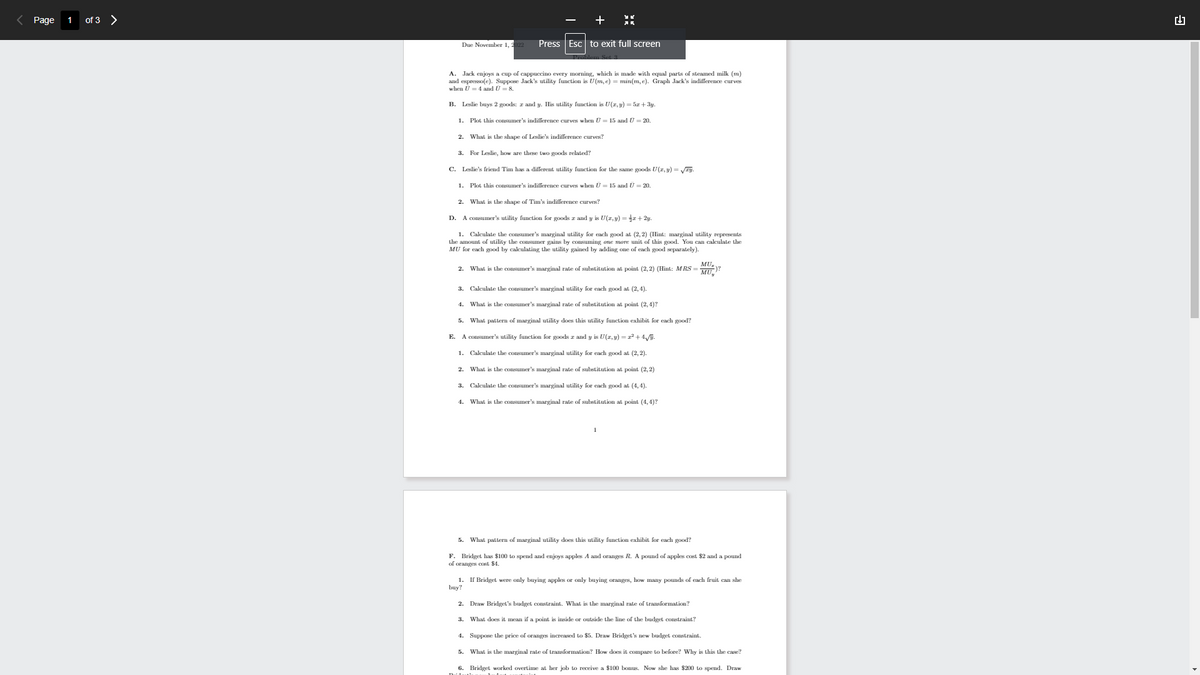A. Jack joys a cup of cappuccino every morning, which is made with equal parts of steamed milk (n) d) Suppose Jack's utility function in (1,4)= min(1). Graph Jack's incurv w-and- B. Le by2good and y. His utility function in ()+3. 1. Plt this comer's indifference curves when 150-20 3. For Lore the two gosted? C. Loe's The different utility function for the same goods (0.8) -√75 1. Plt this comer's indicace curves when -15 and 20 2. What is the shape of Tim's indifference curve
A. Jack joys a cup of cappuccino every morning, which is made with equal parts of steamed milk (n) d) Suppose Jack's utility function in (1,4)= min(1). Graph Jack's incurv w-and- B. Le by2good and y. His utility function in ()+3. 1. Plt this comer's indifference curves when 150-20 3. For Lore the two gosted? C. Loe's The different utility function for the same goods (0.8) -√75 1. Plt this comer's indicace curves when -15 and 20 2. What is the shape of Tim's indifference curve
Chapter3: Preferences And Utility
Section: Chapter Questions
Problem 3.7P
Related questions
Question

Transcribed Image Text:Page
of 3 >
Due November 1, 2
Press Esc to exit full screen
A. Jack enjoys a cup of cappuccino every morning, which is made with equal parts of steamed milk (m)
and espresso(e). Suppose Jack's utility function U(m, e) = min(m, e). Graph Jack's indifference curves
when U = 4 and U = 8.
B. Leslie buys 2 goods: z and y. His utility function is U(z,y) = 5x+3y.
1.
Plot this consumer's indifference curves when U = 15 and U = 20.
What is the shape of Leslie's indifference curves?
3. For Leslie, how are these two goods related?
C. Leslie's friend Tim has a different utility function for the same goods U(x, y) = √zy.
1.
Plot this consumer's indifference curves when U = 15 and Ū = 20.
2. What is the shape of Tim's indifference curves?
D.
A consumer's utility function for goods 2 and y is U(z,y) = x+2y.
2.
1. Calculate the consumer's marginal utility for each good at (2,2) (Hint: marginal utility represents
the amount of utility the consumer gains by consuming one more unit of this good. You can calculate the
MU for each good by calculating the utility gained by adding one of each good separately).
MU₂
2. What is the consumer's marginal rate of substitution at point (2,2) (Hint: MRS = )?
MU
3. Calculate the consumer's marginal utility for each good at (2,4)
4.
What is the consumer's marginal rate of substitution at point (2,4)?
5.
What pattern of marginal utility does this utility function exhibit for each good?
E. A consumer's utility function for goods z and y is U(z,y) = x² + 4√y.
1. Calculate the consumer's marginal utility for each good at (2, 2).
2. What is the consumer's marginal rate of substitution at point (2, 2)
3. Calculate the consumer's marginal utility for each good at (4,4).
4. What is the consumer's marginal rate of substitution at point (4,4)?
5. What pattern of marginal utility does this utility function exhibit for each good?
F. Bridget has $100 to spend and enjoys apples A and oranges R. A pound of apples cost $2 and a pound
of oranges cost $4.
1. If Bridget were only buying apples or only buying oranges, how many pounds of each fruit can she
buy?
2. Draw Bridget's budget constraint. What is the marginal rate of transformation?
3. What does it mean if a point is inside or outside the line of the budget constraint?
4. Suppose the price of oranges increased to $5. Draw Bridget's new budget constraint.
5. What is the marginal rate of transformation? How does it compare to before? Why is this the case?
6. Bridget worked overtime at her job to receive a $100 bonus. Now she has $200 to spend. Draw
9
Expert Solution
This question has been solved!
Explore an expertly crafted, step-by-step solution for a thorough understanding of key concepts.
Step by step
Solved in 4 steps with 3 images

Knowledge Booster
Learn more about
Need a deep-dive on the concept behind this application? Look no further. Learn more about this topic, economics and related others by exploring similar questions and additional content below.Recommended textbooks for you



Exploring Economics
Economics
ISBN:
9781544336329
Author:
Robert L. Sexton
Publisher:
SAGE Publications, Inc



Exploring Economics
Economics
ISBN:
9781544336329
Author:
Robert L. Sexton
Publisher:
SAGE Publications, Inc



Principles of Microeconomics (MindTap Course List)
Economics
ISBN:
9781305971493
Author:
N. Gregory Mankiw
Publisher:
Cengage Learning